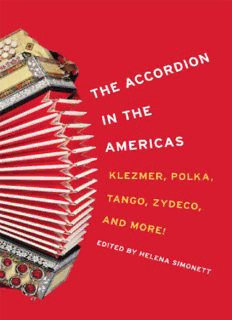
The Accordion in the Americas. Klezmer, Polka, Tango, Zydeco, and More! PDF
Preview The Accordion in the Americas. Klezmer, Polka, Tango, Zydeco, and More!
The Accordion in the Americas MUSIC IN AMERICAN LIFE A list of books in the series appears at the end of this book. The Accordion in the Americas Klezmer, Polka, Tango, Zydeco, and More! Edited by HELENA SIMONETT UNIVERSITY OF ILLINOIS PRESS Urbana, Chicago, and Springfield © 2012 by the Board of Trustees of the University of Illinois All rights reserved Manufactured in the United States of America 1 2 3 4 5 C P 5 4 3 2 1 This book is printed on acid-free paper. Library of Congress Cataloging-in-Publication Data The accordion in the Americas : klezmer, polka, tango, zydeco, and more! / edited by Helena Simonett. p. cm. — (Music in American life) Includes index. 978-0-252-03720-7 (cloth) 978-0-252-07871-2 (pbk.) 1. Accordion—United States—History. 2. ISBN ISBN Accordionists—United States. 3. Accordion music—United States—Social aspects. 4. Immigrants—United States—Music—History and criticism. I. Simonett, Helena, editor. 1083.a23 2012 ML 788.8'6097—dc23 2012008976 Contents Introduction HELENA SIMONETT Chapter 1 From Old World to New Shores HELENA SIMONETT Chapter 2 Accordion Jokes: A Folklorist’s View RICHARD MARCH Chapter 3 From Chanky-Chank to Yankee Chanks: The Cajun Accordion as Identity Symbol MARK F. DEWITT Chapter 4 ’Garde ici et ’garde lá-bas: Creole Accordion in Louisiana JARED SNYDER Chapter 5 “Tejano and Proud”: Regional Accordion Traditions of South Texas and the Border Region CATHY RAGLAND Chapter 6 Preserving Territory: The Changing Language of the Accordion in Tohono O’odham Waila Music JANET L. STURMAN Chapter 7 Accordions and Working-Class Culture along Lake Superior’s South Shore JAMES P. LEARY Chapter 8 Play Me a Tarantella, a Polka, or Jazz: Italian Americans and the Currency of Piano-Accordion Music CHRISTINE F. ZINNI Chapter 9 The Klezmer Accordion: An Outsider among Outsiders JOSHUA HOROWITZ Chapter 10 Beyond Vallenato: The Accordion Traditions in Colombia EGBERTO BERMÚDEZ Chapter 11 “A Hellish Instrument”: The Story of the Tango Bandoneón MARÍA SUSANA AZZI Chapter 12 No ma’ se oye el fuinfuán: The Noisy Accordion in the Dominican Republic SYDNEY HUTCHINSON Chapter 13 Between the Folds of Luiz Gonzaga’s Sanfona: Forró Music in Brazil MEGWEN LOVELESS Chapter 14 The Accordion in New Scores: Paradigms of Authorship and Identity in William Schimmel’s Musical “Realities” MARION S. JACOBSON Glossary Contributors Index The Accordion in the Americas Figure 0.1 Accordion traditions in the Americas. Map by Helena Simonett. Introduction HELENA SIMONETT When my grandfather would reach for his button accordion, a pre – World War I Schwyzerörgeli (“little Swiss organ”), his grandchildren would gather at his feet and listen. I marveled how his calloused fingers could run so effortlessly up and down the keyboard and produce this magic sonorous tone: he made his instrument purr like a cat sleeping on the stove bench. I also remember the bellows changing color, showing beautiful wallpaper when pulled apart, and the alpine flowers that decorated the wooden frame. But I began to detest this sound of my childhood, and more generally Swiss folk music, when I entered my adolescent years. I don’t think I ever knew, or wanted to know, the reason for my rejection—the music was just old-fashioned and corny. Not so with Tex-Mex or New Tango, though! I fell in love with Flaco Jiménez, with his shiny gold crown exposed by his wide smile and energetic accordion playing, after seeing the documentary film Polka: Roots of Mexican Accordion Playing on the Borderline between South Texas and North Mexico, produced by the Dutch anthropologist Robert Boonzajer Flaes and filmmaker Marteen Rens in 1986. Boonzajar Flaes, who taught visual anthropology at the University of Amsterdam, cunningly juxtaposes Jiménez and Austrian accordionists trying to play each other’s polka styles (after listening to a tape), with the former—of course—much more successful than the latter. While I discovered an array of new “world musics” (many of which feature the accordion prominently, I have to point out), some young people from my part of the country thought Swiss folk was cool and began to fully embrace “ethnic” music—a trend that grew after the mid-1980s and in the 1990s. Yet we all came full circle: “folk accordionists” such as Pareglish’s Markus Flückiger play everything from “urchig” (original Swiss) to Finnish, Irish, Chinese, and klezmer; my own Schwyzerörgeli is at arm’s distance as I edit this volume. This volume is, in a way, my “coming out of the
Description: